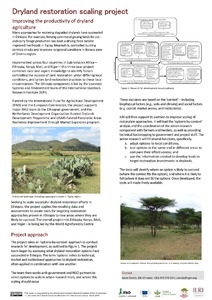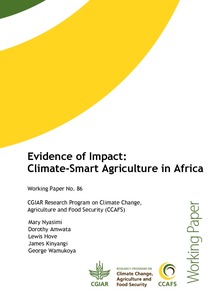Dryland restoration scaling project: Improving the productivity of dryland agriculture
Economic benefits of climate-smart agricultural practices to smallholder farmers in the Indo-Gangetic Plains of India
Small landholders can implement a range of climatesmart agricultural (CSA) practices and technologies, in order to minimize the adverse effects of climate change and variability, but their adoption largely depends on economic benefits associated with the practices. To demonstrate the potential economic benefits of CSA practices, we conducted a study with smallholder farmers in the Indo-Gangetic Plains (IGP) of India.
East African food security as influenced by future climate change and land use change at local to regional scales
Climate change impacts food production systems, particularly in locations with large, vulnerable populations. Elevated greenhouse gases (GHG), as well as land cover/land use change (LCLUC), can influence regional climate dynamics. Biophysical factors such as topography, soil type, and seasonal rainfall can strongly affect crop yields. We used a regional climate model derived from the Regional Atmospheric Modeling System (RAMS) to compare the effects of projected future GHG and future LCLUC on spatial variability of crop yields in East Africa.
Effects of burning and grazing on native savanna in the Colombia Eastern Plains (Carimagua)
Se presenta informacion preliminar acerca del proceso y las causas de sucesion de sabanas de Trachypogon vestitus y de Paspalum pectinatum despues de quema y pastoreo, en Carimagua, Colombia. En varios expt. en los cuales se aplicaron diferentes tasas de carga a parcelas con y sin quema, se observo que la cobertura de plantas tendio a ser mayor en las parcelas con quema, a la mayor tasa de carga y al inicio y al final de la epoca seca. La quema y el pastoreo no afectaron el no. de plantas emergentes. Despues de la quema y con tasa de carga baja, T. vestitus predomino en la sabana de P.
Effects of salinity and drought on early seedling growth and survival of Artemisia herba-alba
Seedlings of Artemisia herba-alba grown in glasshouse were watered with differing salinities (0, 150, 250 or 350 mM NaCl) and watering frequencies of 3, 7, 14 or 21 days for a period of 6 weeks. At the end of the study, plant survival, dry matter yield, biomass allocation (shoot and root), leaf area, relative growth rate (RGR), net assimilation rate (NAR), specific leaf area (SLA) and leaf area ratio (LAR) were recorded. When watered with 0 mM NaCl, Artemisia herba-alba plants had similar (P> 0.9) final dry matter weight and 100% survival regardless of watering frequency.
Empowering a local community to address climate risks and food insecurity in Lower Nyando, Kenya
In erosion- and drought-prone Nyando, self-help groups affiliated to large umbrella bodies are working with extension agents, researchers and development partners to improve local livestock and diversify crops, to improve soil and water management, and to pool financial and labour resources.
Energy recovery from domestic and agro-waste streams in Uganda: a socioeconomic assessment
Recovering energy from waste offers dual benefits – a) improved waste management, and b) provision of reliable energy to households, institutions and commercial entities. In this report, we present a socioeconomic assessment of three energy business models (briquette manufacturing, on-site (public toilet) energy generation, and agro-waste electricity generation) based on feasibility studies carried out in the city of Kampala, Uganda.
Evaluating irrigation technologies to improve crop and water productivity of onion in Dangishta watershed during the dry monsoon phase
Evaluation of the use of fresh water by four Egyptian farms applying integrated aquaculture – agriculture
Evidence of Impact: Climate-Smart Agriculture in Africa
The vulnerability of Africa’s agriculture to climate change is complex. It is shaped by biophysical, economic, socio-cultural, geographical, ecological, institutional, technological and governance processes that interact in intricate ways, and can together reduce farmers’ adaptive capacity. Women farmers with few resources are particularly vulnerable. This working paper highlights the array of adaptation strategies that exist across Africa’s diverse farming systems and climatic conditions. These strategies can provide the impetus for transforming Africa’s agriculture.










